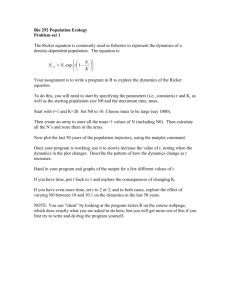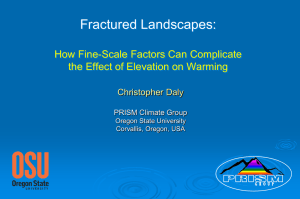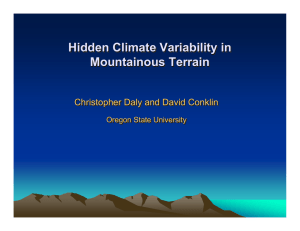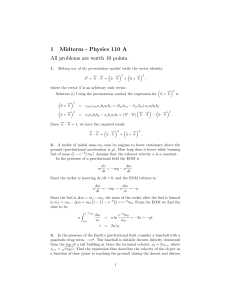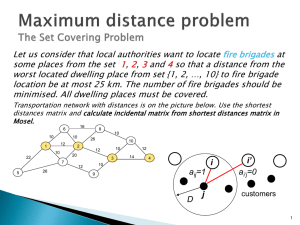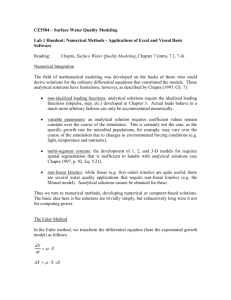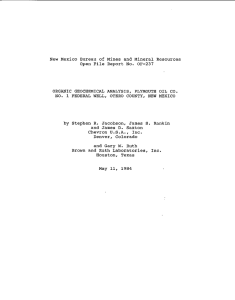Multiscale Total Variation (MTV) Regularization Models in Image Restoration Michael Hinterm¨ uller
advertisement
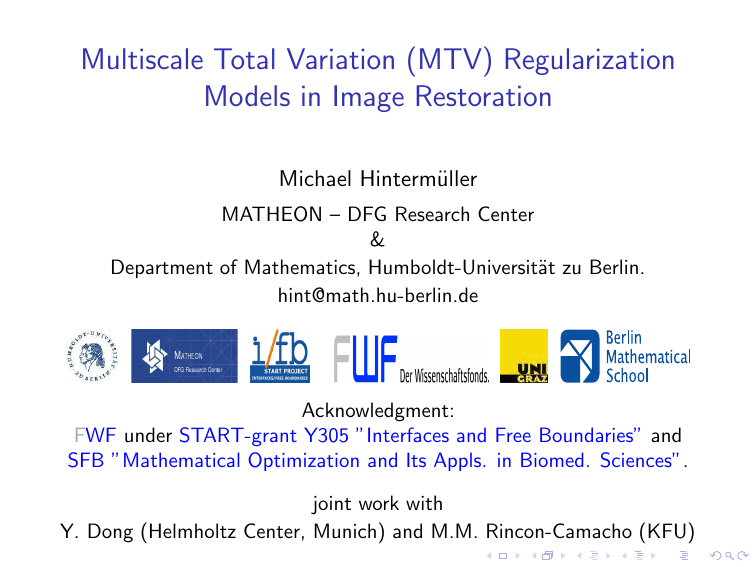
Multiscale Total Variation (MTV) Regularization
Models in Image Restoration
Michael Hintermüller
MATHEON – DFG Research Center
&
Department of Mathematics, Humboldt-Universität zu Berlin.
hint@math.hu-berlin.de
Acknowledgment:
FWF under START-grant Y305 ”Interfaces and Free Boundaries” and
SFB ”Mathematical Optimization and Its Appls. in Biomed. Sciences”.
joint work with
Y. Dong (Helmholtz Center, Munich) and M.M. Rincon-Camacho (KFU)
Motivation - Noisy original.
Motivation - Noisy original.
Scalar regularization parameter choice: keep details vs. removing noise in
homogeneous features.
Rudin-Osher-Fatemi-model.
Degradation model.
K û + η = z ∈ L2 (Ω),
K ∈ L(L2 (Ω)) and η related to white Gaussian noise with variance σ 2 .
Constrained formulation.
R
minimize J(u) := Ω |Du| over u ∈ BV (Ω)
R
R
R
subject to Ω Ku dx = Ω z dx, Ω |Ku − z|2 dx = σ 2 |Ω|,
R
with Ω |Du| the usual BV-seminorm and |Ω| the volume of Ω.
Unconstrained formulation.
Z
Z
λ
|Du| +
minimize
|Ku − z|2 dx over u ∈ BV (Ω)
2 Ω
Ω
for a suitably chosen λ > 0.
Localized ROF-model.
We are interested in...
Z
Z
1
minimize
|Du| +
λ(x)|Ku − z|2 (x)dx over u ∈ BV (Ω), (Puncon )
2 Ω
Ω
where λ ∈ L∞ (Ω) is determined automatically.
Literature.
”Deterministic” scales.
[Strong, Chan], [Strong, Aujol, Chan].
Discrete local models + statistics.
[Almansa, Ballester, Caselles, Haro], [Facciolo, Almansa, Aujol,
Caselles].
Localization.
Normalized filters. w ∈ L∞ (Ω × Ω), w ≥ 0 on Ω × Ω with
Z Z
Z Z
w (x, y )φ2 (y )dy dx ≥ ǫkφk2L2 (Ω)
w (x, y )dydx = 1 and
Ω
Ω
Ω
Ω
for all φ ∈ L2 (Ω) for some ǫ > 0 (independent of φ). May use mean,
Gaussian, or Wiener filter.
Localized residual (variance).
Z
w (x, y )(Ku − z)2 (y ) dy .
S(u)(x) :=
Ω
Localized ROF-model – constrained form.
R
minimize J(u) = Ω |Du| over u ∈ BV (Ω)
subject to S(u) − σ 2 ≤ 0
a.e. in Ω.
(P)
Existence & multipliers.
Assumptions on K .
◮
K does not annihilate constant functions.
◮
K · 1 = 1.
Thm. [coercivity for existence]. kukBV → +∞ implies J (u) → +∞
with
Z Z
J (u) = J(u) +
w (x, y )(Ku − z)2 (y ) dy dx.
Ω
Ω
Further properties.
Assumption. Let u1 , u2 ∈ BV (Ω) denote two solutions of (P) with
u1 6= u2 . If there exist δ > 0 and Ωδ ⊂ Ω with |Ωδ | > 0 such that
2
1
1
(Ku1 − z)2 + (Ku2 − z)2 − δ a.e. in Ωδ
K (u1 + u2 ) − z
≤
2
2
then there exists ǫδ > 0 such that
2
Z
1
w (x, y ) K (u1 + u2 ) − z (y )dy ≤ σ 2 − ǫδ
2
Ω
for almost all x ∈ Ω.
Existence & multipliers.
Then...
inf
c∈R
Z
Ω
w (x, y )(c − z)2 (y )dy > σ 2 a.e. in Ω
and for every solution ũ of (P) K ũ has the same value.
Multipliers. Define the penalty problem
Z
γ
minimize Fγ (u) := J(u)+
max(S(u)−σ 2 , 0)2 dx
2 Ω
over u ∈ BV (Ω),
(Ppen )
with γ > 0 a penalty parameter.
Thm. [consistency]. Problem (Ppen ) admits a solution uγ ∈ BV (Ω) for
every γ > 0, and for γ → +∞ {uγ } converges along a subsequence
weakly in L2 (Ω) to a solution of (P).
Further property.
◮
√
k max(S(uγ ) − σ 2 , 0)kL2 (Ω) = O(1/ γ).
Existence & multipliers.
Define
λ◦γ
:=
λγ
:=
γ max(S(uγ ) − σ 2 , 0),
Z
w (x, y )λ◦γ (x) dx.
Ω
Note: λγ related to Fréchet-derivative of penalty term in (Ppen ).
Thm. [multipliers]. Under appropriate assumptions, ∃ λ̃ ∈ L∞ (Ω), a
bounded Borel measure λ̃◦ and a subsequence {γnk } such that:
R
R
(i) Ω λγnk f dx → Ω λ̃f dx for all f ∈ L1 (Ω) and λ̃ ≥ 0 a.e. in Ω.
(ii) There exists j(ũ) ∈ ∂J(ũ) such that
Z
hj(ũ), v iBV (Ω)∗ ,BV (Ω) +2 (K ∗ λ̃(K ũ−z))v dx = 0
Ω
(iii)
for all v ∈ BV (Ω).
R
R
ϕλ◦ dx → Ω ϕd λ̃◦ for all ϕ ∈ C (Ω̄), λ̃◦ ≥ 0 and
RΩ ◦ γnk
λ (S(uγn ) − σ 2 ) dx → 0.
Ω γn
Existence & multipliers.
Under additional regularity, (iii) equivalent to
λ̃◦ ≥ 0 a.e. in Ω,
for arbitrary and fixed ρ > 0.
λ̃◦ = λ̃◦ + ρ max(S(ũ) − σ 2 , 0)
Local variance estimator.
Continue in discrete terms...
Local window.
Ωω
i ,j
ω−1
ω−1
≤ s, t ≤
.
= (s + i, t + j) : −
2
2
Local residual/variance (mean filter).
Siω,j :=
1
ω2
2
X
(s,t)∈Ωω
i ,j
(zs,t − (Ku)s,t ) =
1
ω2
X
2
(rs,t )
(s,t)∈Ωω
i ,j
2
with r = z − Ku ∈ Rm .
Suitable upper bound on local variance. Random variable
Tiω,j =
1
σ2
X
(ηs,t )2
(s,t)∈Ωω
i ,j
has χ2 -distribution with ω 2 degrees of freedom, i.e. Tiω,j ∼ χ2ω2 .
(LVE)
Local variance estimator.
Brief discussion...
If u = û satisfies η = z − K û, then
Siω,j =
1
ω2
X
(s,t)∈Ωω
i ,j
(zs,t − (K û)s,t )2 =
1
ω2
X
(ηs,t )2 =
(s,t)∈Ωω
i ,j
σ2 ω
T .
ω 2 i ,j
On the contrary, if u is an over-smoothed restored image, then the
residual z − Ku contains details, and we expect in detail regions
Siω,j =
1
ω2
X
(s,t)∈Ωω
i ,j
(zs,t − (Ku)s,t )2 >
1
ω2
X
(s,t)∈Ωω
i ,j
(ηs,t )2 =
σ2 ω
T .
ω 2 i ,j
Thus. Search for bound B such that Siω,j > B for some pixel (i, j) implies
that details left in residual in neighborhood of this pixel.
For ease of notation: Tkω := Tiω,j with k = i + (m − 1)j for i, j = 1, . . . m.
Local variance estimator.
Graphical sketch...
Siω,j :=
1
ω2
X
(s,t)∈Ωω
i ,j
2
(zs,t − (Ku)s,t )
Distribution of max.
Bound B depends on size of the image (m × m) and on size of window
(ω × ω) and should be satisfied by ”all” local residuals. Thus,
B ω,m :=
σ2
E( max T ω ),
ω 2 k=1,...,m2 k
with E the expected value of a random variable.
Distribution of max. We have Tkω , k = 1, . . . , N := m2 . Let f be the
χ2 -distribution with ω 2 degrees of freedom, and
F(T ) =
Z
T
f(z)dz.
(cumulat. distrib. fctn.)
−∞
Maximum value of N observations distributed along f denoted by Tmax .
Goal. Describe distribution fmax of maximum value.
Distribution of max.
Distribution [Gumbel; 1935].
fmax [y (Tmax )] = Nf(Tdom )e −y(Tmax )−e
−y (Tmax )
,
(1)
with
◮
y (T ) = Nf(Tdom )(T − Tdom ) the standardization of T .
◮
Tdom so-called dominant value
F(Tdom ) = 1 −
1
.
N
Cumulative distribution function.
Fmax (T ) = P(Tmax ≤ T ) = e −e
−y (T )
.
Expected value and standard deviation of the standardized variable
y (Tmax ).
π
E(y (Tmax )) = κ and d(y (Tmax )) = √ ,
6
respectively, where κ = 0.577215 is the Euler-Mascheroni constant
.
Distribution of max + choice of bound.
Expected value and standard deviation of Tmax .
E(Tmax ) = Tdom +
κ
π
√ with βmax = Nfmax (Tdom ).
and d(Tmax ) =
βmax
βmax 6
Confidence levels. Probability that the maximum value is below or
equal E(Tmax ) is
P(Tmax ≤ E(Tmax )) = e −e
−y (E(Tmax ))
= e −e
−κ
= 0.57037
and that the maximum value is not larger than E(Tmax ) + d(Tmax ) is
P(Tmax ≤ E(Tmax )+d(Tmax )) = e −e
−y (E(Tmax )+d(Tmax ))
= e −e
π
−κ− √
6
Choice of bound.
B ω,m :=
σ2
(E(Tmax ) + d(Tmax ))
ω2
(> σ 2 ).
= 0.85580.
Selection of λ.
Decision based on Siω,j .
Noise only – no details, if
Siω,j ∈ [0, B ω,m ) .
Rule: Keep current λ-value at such pixels.
Modified local variance estimator S̃ ω . Defined by
ω
Si ,j if Siω,j ≥ B ω,m ,
ω
S̃i ,j :=
σ2
otherwise .
Selection of λ.
S̃ for different window sizes: S̃ 5 (left), S̃ 7 (middle), S̃ 9 (right).
Selection of λ and MTV.
Update rule.
(λ̃k+1 )i ,j
:=
(λk+1 )i ,j
=
(λ̃k )i ,j + ρ max((S̃kω )i ,j − σ 2 , 0) = (λ̃k )i ,j + ρ((S̃kω )i ,j − σ 2 ),
1 X
(λ̃k+1 )s,t ,
ω2
ω
(s,t)∈Ωi ,j
where ρ > 0.
Basic M(ultiscale)T(total)V(variation)-Algorithm.
1: Initialize λ0 := λ̃0 ∈ Rm×m
and set k := 0.
+
2: Let uk denote the solution of the discrete version of the
minimization problem (Puncon ) with discrete λ = 2λk .
3: Update λk+1 based on uk and the rule above.
4: Stop, or set k := k + 1 and return to step 2.
Hierarchical decomposition.
Generalize work by [Tadmor, Nezzar, Vese] (TNV-method)...
Considering dyadic scales, hierarchical decomposition works as follows:
(i) Choose λ0 > 0, λ0 ∈ L∞ (Ω) and compute
Z
Z
1
u0 := arg min
|Du| +
λ0 (Ku − z)2 dx.
2 Ω
u∈BV (Ω) Ω
(ii) For j = 0, 1, 2 . . . set λj = 2j λ0 and vj = z − Kuj . Then compute
Z
Z
1
λj+1 (Ku − vj )2 dx, uj+1 := uj + ûj .
ûj := arg min
|Du|+
2 Ω
u∈BV (Ω) Ω
Note: for simplicity u0 and ûj , j = 0, 1, . . ., assumed unique.
Hierarchical decomposition & its performance.
Iterations 1,2,3,4... (reconstruction / residual)
Hierarchical decomp. ∞ MTV ⇒ Spatially Adapted TV.
SA-TV-Algorithm.
1: Initialize u0 = 0 ∈ Rm×m , λ0 = λ̃0 ∈ Rm×m
(small) and set k := 0.
+
2: If k = 0, compute u0 from discrete version of ROF-problem, else
compute vk = z − Kuk and solve discrete version of
Z
Z
1
min
|Du| +
λ(Ku − vk )2 dx
u∈BV (Ω) Ω
2 Ω
with discretization of λ equal to λk . Let ûk denote corresponding
solution.
3: Update uk+1 = uk + ûk .
4: Based on uk+1 and λ-update rule, update λk+1 .
5: Stop, or set k := k + 1 and return to step 2.
SA-TV vs. TNV.
Iterations 1,2,3. (reconstruction / residual)
SA-TV vs. TNV.
Comparing the results.
SA-TV
TNV
Semismooth-Newton-TV-solver in a nutshell.
Fenchel-dual of regularized primal problem
max
~p ∈ L2 (Ω)
|~p(x)| ≤ 1 a.e. in Ω
1
1
− |||K ∗ λz − div~p |||2H −1 +
2
2
Z
λz 2 dx,
Ω
with |||v |||2H −1 = hHµ,K v , v iH01 ,H −1 and Hµ,K = (K ∗ λK − µ△)−1 ; µ > 0.
For uniqueness of dual variable.
max
~p ∈ L2 (Ω)
|~p(x)| ≤ 1 a.e. in Ω
where β > 0.
1
1
− |||K ∗ λz − div~p |||2H −1 +
2
2
Z
Ω
λz 2 dx −
β
2
Z
Ω
k~p k2L2 .
Semismooth Newton TV-solver in a nutshell.
Nonsmooth optimality system.
− µ△ū + K ∗ λK ū − div~p¯ = K ∗ λz in H −1 (Ω),
max(β, |∇ū|2 )~p¯ − ∇ū = 0 in L2 (Ω).
In practice: µ = 0.
Solved efficiently by semismooth Newton method:
◮
inexact Newton-steps (typically 10-15 iterations);
◮
only matvecs (3-5 CG steps / Newton iteration);
◮
may be globalized by line search (not necessary in practice);
◮
local superlinear convergence;
◮
[H., Stadler; SISC ’06]; [Dong, H., Neri; SIIMS – SIAM Imag. Sci.
’09]; [H., Rincon-Camacho; Inv. Prob. ’10].
Comparison of methods.
(TV - optim. scalar λ;
(Bregman it.); PSNR = 27.34
PSNR=27.04)
(SA-TV; PSNR = 27.90)
(TNV; PSNR = 26.96)
Comparison of methods.
CPU-ratios and the number of iterations for different methods.
Bregman iteration
TNV-method
Basic MTV-method
SA-TV-method
Data
“Cameraman”
CPU-ratio k
1.56
4
1.3
4
3.53
22
1
3
“Barbara”
CPU-ratio k
1.51
4
1.16
4
4.45
37
1
3
SA-TV
Dependence on initialization of λ.
Further quantitative assessments...
Stability w.r.t. initialization.
30
29
28 5 5
PSNR
5
4 4
3
4
27
3
4
5 5
3
3
4
4
3
3
4
5
4
26
25
24
Cameraman
Barbara
0.5
1
1.5
λ
2
2.5
3
0
PSNR for images restored by our method for different initial λ̄0 .
Dependence on window size.
Stability w.r.t. window size for localization.
29
28.5
28
PSNR
27.5
27
26.5
26
Cameraman
Barbara
25.5
25
4
6
8
10
12
ω
14
16
18
20
22
PSNR for results obtained by our method with different ω.
Dependence on window size.
Reconstructions for different window sizes (a) ω = 3, (b) ω = 7, (c)
ω = 13, (d) ω = 17.
(a)
(b)
(c)
(d)
Dependence on noise level.
Different noise levels (a) σ = 0.1, (b) σ = 0.2, (c) σ = 0.3.
0
10
20
30
40
50
5
10
15
20
5
10
15
20
25
Final λ.
(Cameraman)
(Barbara)
Extensions.
◮
L1-TV.
M.H., M.M. Rincon-Camacho: Expected absolute value estimators
for a spatially adapted regularization parameter choice rule in
L1 -TV-based image restoration, Inverse Problems, 2010.
Z
Z
minimize
λ(x)|Ku − z|(x)dx +
|Du| over u ∈ BV (Ω).
Ω
◮
◮
Ω
Random-valued impulse noise or salt-and-pepper noise.
Localization: Use expected absolute value
Z ∞
E (|η|) =
|xη |f (xη )dxη ,
−∞
with f the associated probability density function.
Extensions.
Salt-and-pepper noise (noise level 0.5) with Gaussian blur (9 × 9 pixel
window).
6.5
6
5.5
5
4.5
4
3.5
3
2.5
2
(a)
(b)
(c)
Extensions.
◮
Color images.
Y. Dong, M.H., M.M. Rincon-Camacho: A multi-scale vectorial
Lτ -TV framework for color image restoration, International Journal
of Computer Vision, 2010.
Z
Z
1
τ
minimize
λ(x)|K u − z|τ (x)dx +
|Du| over u ∈ BV(Ω)
τ Ω
Ω
with
Z
Ω
|Du| := sup u · div v : v ∈ Cc1 (Ω; RM×2 ); |v|F ≤ 1 in Ω .
M . . . number of color channels; τ ∈ [1, 2].
Extensions.
Salt-and-pepper noise (noise level 0.6) with cross-channel average,
Gaussian, and motion blur.
(a)
(b)
(c)
Extensions.
Framework suitable for more general inverse problems:
minimize J(u)
s.t.
S ω (R(u)) ≤ m(η) a.e.
where J encodes regularization, S ω localization, R a residual, and m a
statistical measure compatible with S ω .
Extensions.
◮
A posteriori error estimates for adaptive finite element discretization
(AFEM) with M.M. Rincon-Camacho.
1
1
0.9
0.9
0.8
0.8
0.7
0.7
0.6
0.6
0.5
0.5
0.4
0.4
0.3
0.3
0.2
0.2
0.1
0
0.1
0
0.2
0.4
0.6
0.8
1
0
0
0.2
0.4
0.6
0.8
1
Summary.
◮
◮
Localized regularization in L2 -TV models (localizing residuals
through filters).
Relation: Regularization parameter ↔ Lagrange multiplier.
◮
Local variance estimator + statistics (distribution of
maximum of M random variables).
◮
Hierarchical decomposition.
◮
◮
Semi-smooth Newton solver for L2 -TV (and also L1 -TV).
Extensions
◮
◮
◮
◮
L1 -TV.
Color-TV.
Generalization potential.
AFEM.
